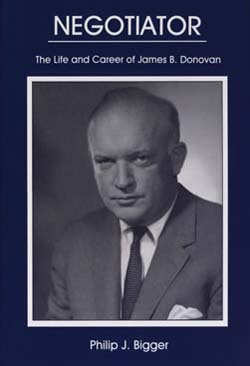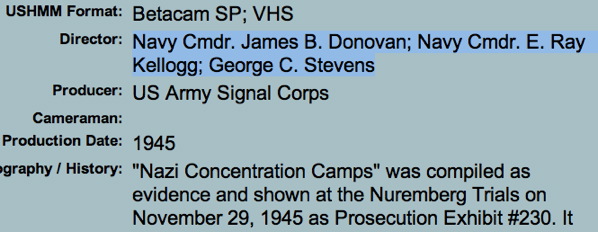[back] Holocaust revisionism

James B. Donovan
[back]
Holocaust
revisionism
See: Nuremberg Buchenwald Flyer Sources
BUCHENWALD A Dumb Dumb Portrayal Of Evil
Director: Nazi Concentration Camps
[See:
[1945-48] Dachau Trials.]
At the Nuremberg International Military Tribunal which
prosecuted the German war criminals in Novemer 1945, three members of the
American prosecution team provided sworn affidavits, testifying to the existence
of lethal gas chambers at the Dachau concentration camp, but these affidavits
were not introduced into the proceedings of the
American Military Tribunal at Dachau, which also began in November 1945.
The affidavits were signed by James
B. Donovan, Lt. Col. Calvin A. Behle of the Judge Advocate General's Department
and Lt. Hugh C. Daly of the 42nd Rainbow Division of the US Seventh Army which
liberated Dachau. The affidavits were included in Nuremberg Document 2430-PS
which was read in court, but Donovan, Behle and Daly were not present and the
defense had no opportunity to cross-examine them.
US vs. Martin Gottfried Weiss, et al
10. The US Holocaust Memorial Museum website has a digitized version of the movie Nazi Concentration Camps found here. The museum lists the director as being "Navy Cmdr. James B. Donovan" the first name listed of three directors:

To see that William B. Donovan was in the OSS (Office of Strategic Services which is the wartime predecessor of the CIA), we go to the book Justice at Nuremberg by Robert Conot (Published by Carroll & Graf, 1984) In a footnote at the bottom of page 197 we find that James B. Donovan was general counsel of the OSS and involved with the movies being shown at Nuremberg. Conot however mistakenly refers to "James B. Donovan" as "James G. Donovan." Below is page 197 of Conot's book. Even though the film being discussed in the following passage is not the film Nazi Concentration Camps, what we get from the excerpt is confirmation that James B. Donovan was in the OSS, particularly in the footnote at the bottom. Keep in mind that the page mentions two people with the last name of Donovan, William Donovan was head of the OSS Buchenwald Flyer Sources
Another piece of evidence to show the OSS's involvement in making the film Nazi Concentration Camps occurs in the beginning of the film where there is the reading of two sworn affidavits which attest to the authenticity of the footage. Each affidavit is read in front of a "notary public" type witness. But unknown to the Court or to the public possibly until 2008, the witnesses were two OSS agents: James B. Donovan and John Ford. James B. Donovan is one of the directors of Nazi Concentration Camps, and Ford was the head of the OSS photographic unit; Ford being a famous director at the time. Buchenwald Flyer Sources
Also, another director of Nazi Concentration Camps, E. Ray Kellogg, is connected to the OSS through John Ford. The book "Searching For John Ford" by Joseph McBride (Published by Macmillan, 2003) mentions Kellogg, a special effects technician, being in John Ford's OSS group. See page 321 and page 387. Buchenwald Flyer Sources
See also In the House of the Hangman by Jeffrey K. Olick, page 99 (published by University of Chicago, 2005.) In addition Peter Wyden reminisces about his time in Psyche Warfare during World War II and the role of denazification films on page 54 of The Hitler Virus (Arcade Publishing 2001):
The internet video Buchenwald: A Dumb Dumb Portrayal of Evil episode 8, makes a photo comparison to assert that it is Jackson presenting the table objects to the crowd of Germans on the forced tour. The video then references a number of New York Times articles to show Jackson's connection to Eisenhower. See note 12 for more on Jackson.
12. See an early Blanche Wiesen Cook article called First Comes the Lie: CD Jackson and Political Warfare. Radical History Review #31 (1984.) Also see the book The Chairman: John J. McCloy, the Making of the American Establishment by Kai Bird (Published by Simon & Schuster, 1992.) It has some good information on CD Jackson. Another good source for information on Jackson is The Mighty Wurlitzer by Hugh Wilford (Harvard University Press 2008.)
The lampshade in the footage and the subsequent New York Times reportage of it, is the first source of the lampshade rumour in the USA. The footage made it's way into newsreels shown to American audiences in late April and early May of 1945, and likely was in the footage shown to the House and Senate around the same time (see note 9.) The lampshade itself disappeared after being filmed on April 16, 1945.
The two shrunken heads are portrayed as being Buchenwald inmates, but Buchenwald inmates had their hair cut with clippers upon arriving at camp. In addition, the video Buchenwald: A Dumb Dumb Portrayal of Evil, episode 3 shows camp footage of liberated inmates where all of the inmates have their hair cut extremely short.